In World Economy News 16/06/2017
Emerging markets are doing their own little bit to cushion the blow of Federal Reserve interest-rate hikes, with countries like Brazil already putting the brakes on borrowing, according to Goldman Sachs Group Inc.
Developing nations, excluding China, saw their aggregate annual credit-to-gross domestic product ratio slip one percentage point to 125 percent by the end of last year, the first time the group has deleveraged since the global financial crisis, Jane Wei, a London-based strategist with Goldman Sachs International, said in a June 14 report. The credit gap — or difference between that ratio and its long-term trend — has declined to 4.3 percentage points, down from a peak of 6.6 percent in 2015, according to Wei.
“The narrowing credit gap has given us confidence in the ability of these emerging markets to withstand U.S. rate shocks to a degree, and we expect them to remain resilient in the face of gradual Fed rate hikes,” she said.
Goldman Sachs joins banks including Societe Generale SA in arguing that emerging markets still have scope to withstand monetary tightening in the U.S. The Fed hiked for the second time in 2017 on Wednesday, with Chair Janet Yellen betting the strength of the American job market will outweigh recent signs of weakness in inflation.
MSCI Inc.’s index of emerging market stocks may rise 13 percent over the next 12 months, according to share price estimates compiled by Bloomberg, after posting a 16 percent increase so far this year. The gauge for developing currencies is trading near the highest level since 2014.
Wei took a look at more frequently updated loans data published by central banks and made several observations about 2017:
China has the largest credit gap at 30 percentage points, however the pace of accumulation has slowed. This is “a welcome sign that efforts to rein in financial excesses by policy makers this year have been relatively effective,” she said.
Countries in Latin America have generally deleveraged this year, with Brazil and Peru showing the largest declines in their credit-to-GDP ratios. Chile and Mexico still have large gaps but both places have seen a reduction in credit build-up.
While Turkey, South Africa and Taiwan don’t have large credit gaps, the recent data suggests they’ve seen the largest amount of credit accumulation this year.
“The combination of stronger external balances, high real rates and a progressing deleveraging means that emerging markets should be able to withstand gradual U.S. rate shocks, as the Fed looks to normalize rates further in coming quarters,” Wei said.
